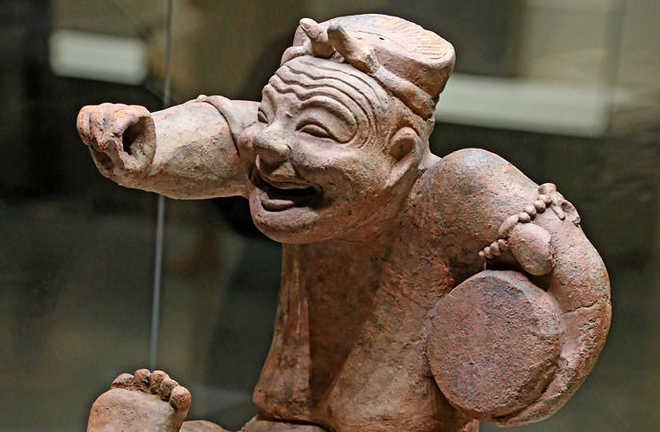Literary scholarship transitions in age of image

The Terracotta Storyteller of the Eastern Han Dynasty (25–220) unearthed in a tomb in Chengdu, Sichuan Province, provides some clues to the art of shuochang (storytelling that combines singing and narration). Photo: PHB.COM
In recent years, the high image-saturation of contemporary society has greatly expanded the boundaries of literary research; it is no longer limited to textual study. Some scholars are concerned about a crisis of literature in the image-saturated society.
The academic resources accumulated in the 20th century through the philosophy of language, phenomenology, ontology and iconology have already set a precedent for the study of the literature-image relationship, providing a theoretical reference for reinterpretion today, said Zhao Xianzhang, a professor from the School of Liberal Arts at Nanjing University. Ideas of and approaches to literary studies are changing.
“If the relationship between image and literature was harmonious and complementary in ancient times, when pictorial art was simply an aid to the art of language, then the arrival of the ‘age of the image’ has reversed this relationship. Supported by technology, the image has intruded into the territory of linguistic expression, with unprecedented strength,’’ said Zhao, speaking of the crisis of literature in the age of the image.
Zhao Yong, a professor from the School of Chinese Language and Literature at Beijing Normal University, expressed the same concern. However, he said that the age of the image does not mean literature will decline. In fact, images and text have a two-way, interactive relationship.
In the view of Long Diyong, dean of the School of Arts at Southeast University, images that have entered the field of literary research, such as various narrative images (story paintings), illustrations of novels or plays and poetic paintings, are more or less connected with literature in its broad sense.
Recognizing the various connections between image and literature, literary researchers are no longer limited to traditional textual study. Wu Hung, director of the Center for the Art of East Asia at the University of Chicago in the United States, studied the relationship between narrative painting and narrative literature in the stone carvings of the Han Dynasty (206 BCE–220 CE).
Wu said that these stone carvings provide not only an interpretation of specific images as part of an iconology, but also some clues on the general questions about the relationship between narrative literature and narrative painting in early China.
As a researcher of ancient Chinese literature, Li Li, a professor from the School of Humanities at Shenzhen University, has been paying attention to newly unearthed archaeological materials.
“The shuochang performance (a kind of storytelling that is part spoken, part sung) that appears in Han stone carvings and other archaeological materials provides valuable visual support for studying the literary texts of shuochang that have been passed down,” Li said. The stone carvings have provided true and rich pictorial materials for the study of Han literature, unmatched by traditional research, thus contributing to the study of Han social culture, customs and art.
Image research in literature has become an important academic growth point. For example, the academic forum on literature and image sponsored by Peking University’s Research Center of Eastern Literature has held two consecutive sessions. The National Social Science Fund’s major project of collecting and researching historical materials of ancient oriental literature has promoted the study of literary images in the academic field across time and space.
“The latest academic achievements mainly include visual narratology, the interrelation of words and image, and cross-media research on literature and the image,” Long said.
Zhao said that since the beginning of this century, the study of the relationship between Chinese literature and image has had two dimensions: One focuses on historical case studies of the relationship between poetry and painting, the relationship between novels and dramas and their illustrations, and the relationship between original literary works and their image adaptations; the other focuses on the macroscopic depiction of the relationship between text and image, as well as research on basic theories.
These two aspects are interrelated and indispensable, Zhao said. If historical research does not refer to relevant theories and becomes only the accumulation and display of data, it will be difficult to respond to the real concern of the literary crisis in the age of the image. If theoretical research is not rooted in history, it will be empty talk.
As such, Zhao said that the combination of history and theory is the ideal realm for the study of the relationship between literature and the image. However, due to the limitations of traditional methods and inherent knowledge structures, it is difficult for some scholars to unify history and theory.
For example, the study of ancient literature through Han stone carvings must involve interpretation and visual analysis of composition, along with the research methods of iconology, art, art history and historiography, Li said. In sociology of literature, studies on Han literature about stone carvings and images may involve qualitative, quantitative and statistical research methods, requiring researchers to take up a multi-dimensional research perspective and interdisciplinary methods.
